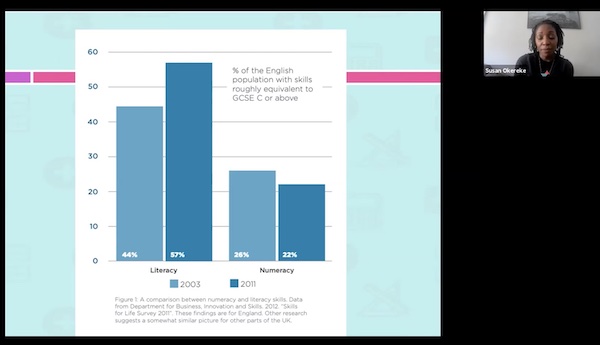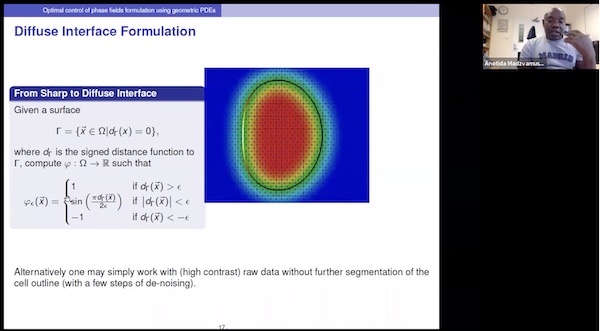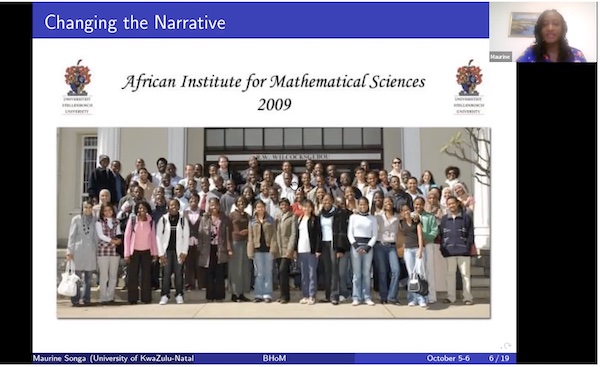
Black Heroes of Mathematics 2021
In his welcome to the 2021 Black Heroes of Mathematics (BHoM) conference, Nira Chamberlain said the aim was to showcase amazing black mathematicians, with speakers from Africa, the US, the Caribbean and the UK. Chamberlain is President of the Institute of Mathematics and its Applications (IMA) and was one of the organisers and the chair of the conference. "The IMA believes mathematics should have no boundaries. We firmly believe that mathematics should be for everybody."
The BHoM is now an annual conference held by a large group of UK and African mathematical organisations: the British Society for the History of Mathematics, the International Centre for Mathematical Sciences, the Institute of Mathematics and its Applications, the Isaac Newton Institute (INI), the London Mathematical Society, ICTP-East African Institute for Fundamental Research, the African Institute for Mathematical Sciences (AIMS) and the Mathematical Association.
Due to the breadth of the audience and speakers, both geographically but also in career stage, the conference covered mathematics and education, with a number of pre-recorded talks that can still be viewed online and live panel discussions with the speakers at the end of each of the two days.
Do the maths thing
One of the talks, pre-recorded due to Susan Okereke's day job as a maths teacher, was a startling review of the state of numeracy in the UK. "Numeracy – having the confidence and competence to use numbers and think mathematically in everyday life – is a life skill,” she said. This skill has as big an impact on people's lives as reading and writing, but rather than matching the improvements in literacy, numeracy levels are falling year on year.

Susan Okereke, during her talk, showing the falling levels of numeracy.
In order to maximise their life chances and make a positive contribution, everybody, everybody has to do maths, says Okereke. "And I have seen with my own eyes that everyone can do maths." Speaking with the authority of someone who works in, and researches, maths education, she explained that improving teaching was only part of the process of improving numeracy. "We need good and relevant content and we need a good learning environment." But perhaps the most important piece of the puzzle is that we need good learners.
Creating good learners is down to all of us. Children need to grow up without hearing "I can't do maths" from their parents, family and friends. Advertisers, writers and film makers need to stop using the lazy stereotype of maths being boring, hard or at worst, a form of punishment. We need, as a society, to celebrate maths and value numeracy as highly as we value literacy.
Modelling cell migration
As well as talks focussing on maths education, there were a mixture of technical talks and testimonial talks. Anotida Madzvamuse, Professor of Mathematical and Computational Biology at the University of Sussex, UK, gave a fascinating technical talk on using mathematics to understand how cells migrate. He began by showing intriguing videos of cells migrating across a flat slide viewed under a microscope. Madzvamuse's work aims to use such experimental data from bioscience to motivate mathematical models to understand wound healing, tumour growth, the development of embryos and many other biological phenomena.
A key part of all these phenomena is how cells change their shape when they are migrating. To gather experimental data, colleagues of Madzvamuse used microscopes to capture static images as cells moved towards a wound in a transparent zebra fish. This whole cell tracking captures the surface area, volume and curvature of the migrating cells, information which is very important for analysing changes that are relevant to applications like wound healing and cancer growth.
The work Madzvamuse presented relies on the mathematical evolution of the shape of cells, taking into account very little information about the biochemistry or the mechanics involved. He uses geometric evolution law models, under which the boundary of an object changes in response to its curvature according to some kind of mathematical rule.
One approach to building such a model would be to explicitly define the boundary of the cell, to treat it as a sharp interface between the interior and exterior of the cell. "This model is great, but it's completely useless as it is intractable!" says Madzvamuse. Instead he and his colleagues use a diffuse interface model, where the cell is approximated by a phase-field that can either be gathered from the data, or from an analytic description of the shape of the cell. Points inside and outside the cell have different values in this phase-field, and the boundary lies on the interface between these two phases.

Madzvamuse, in his talk, explaining his approach to modelling the changing shape of cells during migration.
Rather than needing to model the evolution at every point on the surface of the cell, this diffuse interface model can be solved only over at grid of points over the phase-field, using a more refined grid at the surface of the model where non-linear effects are present, and a coarser grid within the cell where the model is linear. The videos overlaying the experimental work with the modelling show how successfully Madzvamuse and his colleagues have matched the mathematics to the experimental data.
(There is a lovely interview with Madzvamuse with the INI, one of the organisations holding the conference. Madzvamuse was the organiser of a recent program at the INI, Coupling geometric PDEs, on research in this area.)
The power of stories
We also particularly enjoyed the talk by Maurine Atieno Songa, a PhD student at the University of KwaZulu-Natal, South Africa. Songa explained the importance of role models in her life, and the broader importance of telling the stories of mathematical heroes. As she explained, it is the stories of identifiable heroes that can have the greatest impact, rather than the great shining stars of the wider mathematical world.
"An African child in a village needs people they can identify with. That they can look up to and say this is somebody I used to see every day and now they have made it." She said she lacked these identifiable heroes when she was young, being brought up by her maternal grandmother in the western part of Kenya, struggling with the death of her mother. "When you grow up in so much poverty it's not easy to dream beyond your surroundings."
Thanks to a highschool bursary she found someone to look up to, a fellow student a few years ahead of her who went on to university. She went on to study at AIMS (one of the organisations supporting the conference) and met more role models during her career, and now is studying for her PhD. Telling her own story, and the stories of others, is now an important part of the way Songa is supporting other girls to go on to university. And as part of telling her own story she gave us a fascinating and delightfully accessible introduction to her work in category theory.

Songa with fellow graduates at AIMS, in a screen shot from her talk.
Stories helped inspire Songa to pursue mathematics. And people sharing her story further has provided her with many connections, including the one with the BHoM organisers that led her to speak to the conference.
"May the footprints we leave behind by telling these powerful stories of our STEM journeys be a wealth of inspiration to another," she said. Songa and all the other black heroes of mathematics left everyone in the audience, including us, inspired. They gave everyone important ideas to think about and act on to inspire the next generation of mathematicians.
About the author
Rachel Thomas is Editor of Plus.
This article was produced as part of our collaboration with the Isaac Newton Institute for Mathematical Sciences (INI) – you can find all the content from the collaboration here.
The INI is an international research centre and our neighbour here on the University of Cambridge's maths campus. It attracts leading mathematical scientists from all over the world, and is open to all. Visit www.newton.ac.uk to find out more.
